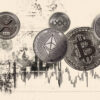XRP’s Bullish Momentum Faces Headwinds Amidst APAC Expansion
XRP is experiencing a slowdown in its recent upward trend, hinting at potential profit-taking and exhaustion among traders. This comes as Ripple increases its investment in the Asia-Pacific region (APAC) with an additional $5 million to foster blockchain innovation.
Despite a 5% surge in the derivatives market’s Open Interest and a trading volume increase to $5.2 billion, suggesting growing bullish sentiment, XRP is struggling to maintain its gains. The token is currently trading around $2.27, down over 2% on the day, as global markets react to ongoing trade negotiations between the U.S. and China.
Ripple Expands Investment in APAC Region
Ripple has boosted its investment in the APAC region by allocating an additional $5 million through its University Blockchain Research Initiative (UBRI). This investment spans six countries, with renewed partnerships in South Korea, Japan, and Singapore, and new grants extended to Taiwan and Australia.
Ripple’s increased focus on APAC reflects the progress made by governments in providing clarity on cryptocurrency regulations and supporting digital finance development. UBRI has been instrumental in building communities of developers, stakeholders, and users, laying the groundwork for blockchain innovation in higher education.
As part of the renewed partnerships, Ripple will invest $1.1 million in Korea University over six years, building on a previous collaboration with Yonsei University. In Japan, Ripple has renewed its partnership with Kyoto University, aiming to advance blockchain research with a $1.5 million grant.
Additionally, $3 million has been allocated to Nanyang Technological University (NTU) in Singapore, extending a partnership with the National University of Singapore (NUS).
“This support allows us to engage more students and researchers in the blockchain ecosystem by enabling them to build on the XRPL and contribute to its growth, thus advancing our blockchain education initiatives,” said Professor Yang Liu of NTU’s College of Computing and Data Science.
In total, UBRI has invested over $11 million to promote education, adoption, and innovation in blockchain and fintech within the APAC region.
Despite the innovative funding announcement, XRP’s upside potential remains constrained, with technical indicators suggesting bearish signals. The token is currently trading between support at $2.25 and resistance at $2.32.
Technical Outlook: XRP Struggles to Sustain Bullish Trend Amid Declining Risk Appetite
XRP’s price is sliding towards the confluence support at $2.25, established by the 50-day and 100-day Exponential Moving Averages (EMAs), after facing rejection around $2.32.
The shaky bullish trend suggests that market sentiment remains cautious, especially with U.S.-China trade negotiations in focus. The Relative Strength Index (RSI) is holding steady at the midline of 50, indicating a lack of conviction in the upward trend. A break below the midline could see losses extend 8% below the current level, testing support at the 200-day EMA around $2.08.
A sell signal from the SuperTrend indicator validates XRP’s downside vulnerability. This indicator signals traders to consider selling XRP when the price falls below the SuperTrend line, changing its color from red to green. Traders often use this trend-following tool as dynamic support and resistance. XRP could maintain a bearish bias as long as the SuperTrend remains above the price.
Meanwhile, the derivatives market has seen a significant increase in Open Interest (OI), rising to $4.34 billion in the last 24 hours, alongside an 11% increase in trading volume to $5.2 billion.
OI refers to the total number of outstanding futures and options contracts that have not been settled or closed. Therefore, an increase in OI alongside trading volume underscores the growing interest in XRP, supported by increased market participation.
If the trend persists, XRP’s price could maintain short-term support at $2.25, allowing bulls to resolve the technical outlook with a potential 30% breakout to $3.00 from the current price level.
Ripple FAQs
It depends on the transaction, according to a court ruling issued on July 14:
– For institutional investors or over-the-counter sales, XRP is a security.
– For retail investors who purchased the token through programmatic sales on exchanges, on-demand liquidity services, and other platforms, XRP is not a security.
The U.S. Securities and Exchange Commission (SEC) accused Ripple and its executives of raising over $1.3 billion through an unregistered asset offering of the XRP token.
Although the judge ruled that programmatic sales are not considered securities, sales of XRP tokens to institutional investors are investment contracts. In the latter case, Ripple did violate U.S. securities law and will have to continue litigating for the approximately $729 million it received under written contracts.
The ruling offers a partial victory for both Ripple and the SEC, depending on what you look at.
Ripple gets a big win over the fact that programmatic sales are not considered securities, and this could bode well for the cryptocurrency sector in general, as most of the assets in the SEC’s sights are handled by decentralized entities that sold their tokens primarily to retail investors through exchange platforms, experts say.
Still, the ruling does little to answer the key question of what makes a digital asset a security, so it is still unclear whether this lawsuit will set a precedent for other open cases affecting dozens of digital assets. Issues such as what is the appropriate degree of decentralization to avoid the “security” label or where to draw the dividing line between institutional and programmatic sales are likely to persist.
The SEC has stepped up its enforcement actions toward the blockchain and digital asset industry, filing charges against platforms such as Coinbase or Binance for allegedly violating U.S. Securities Law. The SEC claims that most crypto assets are Securities and are therefore subject to strict regulation.
While defendants may use parts of the Ripple ruling to their advantage, the SEC may also find in it reasons to maintain its current strategy of regulation through enforcement.
The court ruling is a partial summary judgment. The ruling may be appealed once a final judgment is entered or if the judge allows it earlier. The case is in a pre-trial phase, in which both Ripple and the SEC still have the possibility of reaching an agreement.
Stay ahead of the curve in the fast-paced crypto world – explore the latest updates and trends at Cryptonewsfeeds.com.










